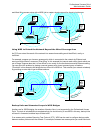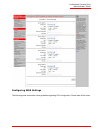
Professional Access Point
Administrator Guide
Wireless Distribution System - 153
Wireless Distribution System
The Professional Access Point lets you connect multiple access points using a Wireless Distribution
System (WDS). WDS allows access points to communicate with one another wirelessly in a standardized
way. This capability is critical to providing a seamless experience for roaming clients and for managing
multiple wireless networks. It can also simplify the network infrastructure by reducing the amount of cabling
required.
The following sections describe how to configure the WDS on the Professional Access Point:
• Understanding the Wireless Distribution System
• Using WDS to Bridge Distant Wired LANs
• Using WDS to Extend the Network Beyond the Wired Coverage Area
• Backup Links and Unwanted Loops in WDS Bridges
• Security Considerations Related to WDS Bridges
• Navigating to WDS Settings
• Configuring WDS Settings
• Example of Configuring a WDS Link
• Updating Settings
Understanding the Wireless Distribution System
A Wireless Distribution System (WDS) is an 802.11f technology that wirelessly connects access points,
known as Basic Service Sets (BSS), to form what is known as an Extended Service Set (ESS).
Using WDS to Bridge Distant Wired LANs
In an ESS—a network of multiple access points—each access point serves part of an area that is too large
for a single access point to cover. You can use WDS to bridge distant Ethernets to create a single LAN.
For example, suppose that you have one access point that is connected to the network by Ethernet and
serving multiple clients in the Conference Room (LAN Segment 1), and another Ethernet-wired access
point serving stations in the West Wing offices (LAN Segment 2). You can bridge the Conference Room
Note
A BSS generally equates to an access point deployed as a single-access-point wireless network. In
cases where multi-BSSID features make a single access point look like two or more access points to
the network, the access point has multiple unique BSSIDs.


















